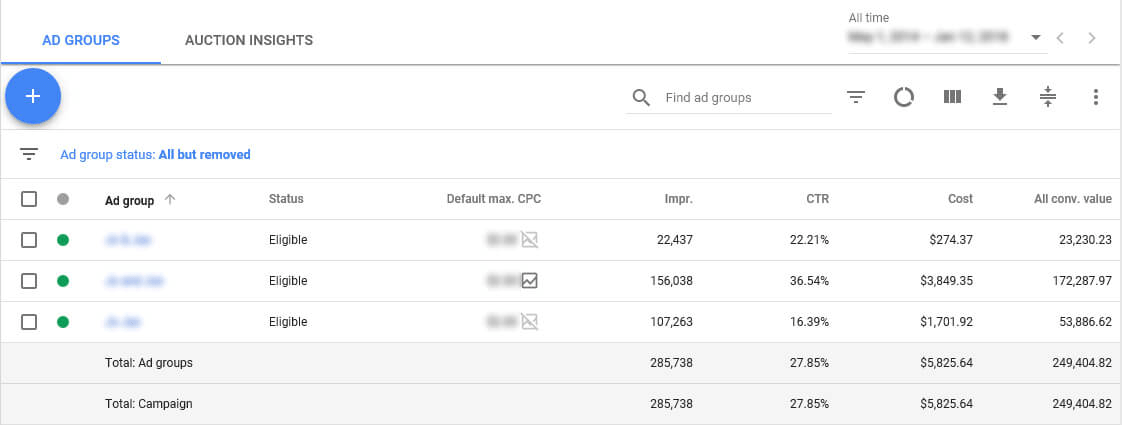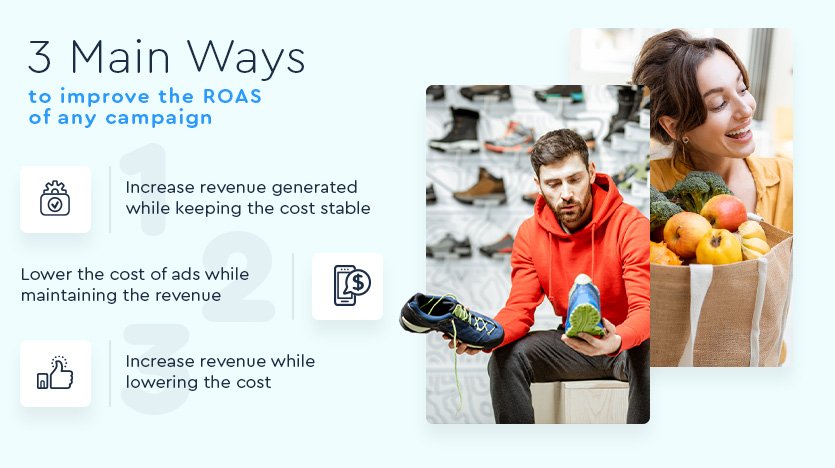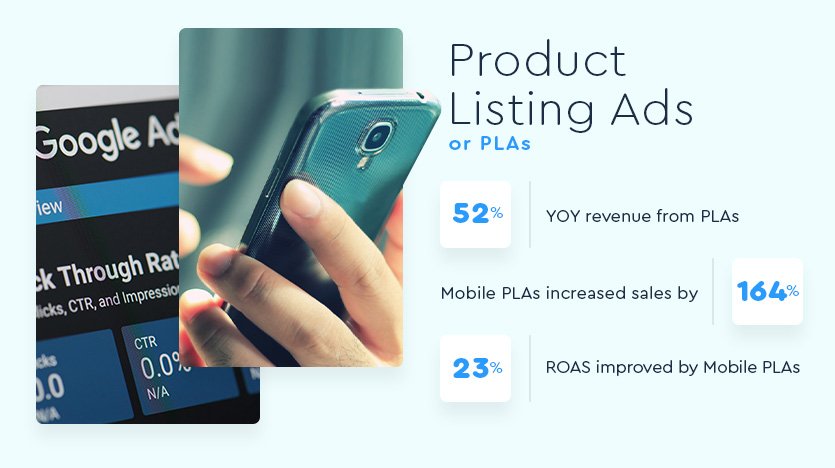For retailers spending money on PPC ads to drive traffic to your ecommerce website, keep in mind that getting the clicks is only half the story. If your ads aren’t effective, they will fail to generate profit.
Do you do know how much revenue your ads are bringing in and whether they’re worth the investment? One of the best ways to find out is to connect the amount you spend on a campaign with the amount of revenue generated.
Think of it this way: If there were a slot machine that gave you $5 every time you put in $1 and pulled the lever, would you keep putting money in?
The answer is simple. Of course you would!
Measuring ROAS (return on ad spend) tells you exactly which ones of your PPC ads are magic slot machines, so you can get the most out of your online advertising dollars.
How to Measure ROAS
You need to track your PPC ads’ conversions and sales metrics in order to improve your ROAS, which is the revenue brought in by a campaign, divided by the amount spent on that campaign. Most paid search platforms offer the ability to track conversion and sales. You can assign a conversion value to transactions and measure the value produced by each campaign.

When measuring ROAS, don’t forget to take into account factors, such as partner or vendor costs and affiliate commissions, to get accurate calculations.
How to Improve the ROAS of Your PPC Campaign
The formula for calculating ROAS is pretty straightforward—divide the revenue generated by the amount spent on an ad campaign.
To improve the ROAS of any campaign, you can:
- Increase the revenue generated while keeping the cost stable.
- Lower the cost of the ads while maintaining the revenue.
- Increase revenue while lowering the cost.

Here’s how to either increase revenue or lower cost so you can boost the ROAS of your PPC campaigns:
Improve Mobile-Friendliness of Your Website
As more consumers are starting online searches on their smartphones, it’s imperative that your website is designed to be mobile-friendly.
It doesn’t matter how enticing your PPC ads are if your website doesn’t deliver a mobile user experience that converts—you’d be paying for the clicks but not getting the conversion!
There are many ways to optimize a mobile shopping experience, such as improving load time, using location services to deliver personalized content, using design elements (e.g., accordion) to unclutter product pages, and streamlining checkout to reduce cart abandonment.
Refine Your Keyword Targeting
Your keyword targeting has to be specific in order to attract visitors who are looking for the exact product you’re advertising and who are ready to make a purchase.
You can optimize each product page or landing page on your website with long-tail keywords to help attract high-quality traffic that’s more likely to convert. Use PPC software or keyword discovery tools to identify highly specific and low competition keywords that are likely to be missed by your competitors, so you can get more clicks at a lower cost.
In addition, you can rank for keywords that indicate high purchase intent. For local businesses, it could be “[ product/service ] in [ your city ]” and, for ecommerce websites, it could be “free shipping.”
Use Geo-Targeting
If you have a brick-and-mortar business, you don’t want to be paying for clicks from people who live 1,000 miles from your store. If you have an ecommerce website and only ship to certain countries, you’d only want to pay for clicks from visitors who live in places to which you ship your products.
To avoid paying for clicks from visitors who wouldn’t be able to buy from you due to their locations, target your ads to those who are initiating their searches from specific geographic areas or who include a specific location in their search terms. You can target your ads by country, region, city, or ZIP code, or by the radius around your store.
Spy on Your Competitors
There are many tools you can use to spy on your competitors’ PPC campaigns so you can see what’s working and what’s not. You can find out the keywords they’re ranking for, the offers they’re promoting, and the copy they’re using.
Remember, driving traffic is only half the story. You also need to identify which ads are actually generating revenue. To do so, analyze longer-term trends to find out which ads are not only getting the clicks but also performing well in terms of time onsite and bounce rates.
In addition, you can infer that an ad is probably generating revenue if a competitor has been running it for a while.
Optimize Your Landing Pages
Remember that getting the click is only the first step? To turn traffic into sales, you need to optimize the user experience from the moment a visitor lands on your website to the time he or she completes a transaction.
One of the biggest mistakes advertisers make is using the same landing page for all their ads, regardless of the different messaging or audiences. Your landing pages should feature content that’s coherent with the ad copy. For example, if you’re promoting a 20% discount on an ad, the landing page should highlight the same offer.
Don’t forget to A/B test landing pages so you can optimize the content and conversion rate.
In addition, make sure you have a process in place—e.g., remarketing campaigns or abandon cart triggered emails—to re-engage visitors who haven’t finished the transaction on their first visit.
Use Conversion Rate Optimization (CRO) Strategies
In order to increase revenue, you need to make sure visitors are converting into customers. Did you know that the global cart abandonment rate of ecommerce sites is 75.6%? That translates to a lot of visitors who put products in their carts but don’t complete the checkout process.
To make sure you capture as much of these potential lost revenues as possible, you need to optimize the path of conversion and reduce the cart abandonment rate of your ecommerce website.
Promote Seasonal Offers
The timeliness of your ads’ messaging, products, and offers can impact your conversion rate. Tailor your ad copy and offers to holidays, events, or anything happening in your niche—e.g., conferences—so it’s not only timely but also helps increase the chances that it will capture the attention of searchers who are looking for information or items related to the event.
In addition, make sure you’re positioning these products on your website in a way that’s relevant for the occasion, to deliver a seamless customer experience that will lead to conversion.
Use the Negative Keyword Feature
Besides increasing revenue from each ad, you can also lower ad cost to increase ROAS. When you pull a search queries report, you may notice that some keywords are getting clicks but not generating any conversion. To increase your ROAS, you don’t want to be paying for these clicks.
Add these keywords to your negative keyword list so searches for these keywords won’t trigger your ad, and you can avoid paying for clicks that don’t convert.
Use Product Listing Ads—PLAs
When you search for a specific product on Google, you often see a list of product photos and links at the top of the search results page.
These product listing ads—PLAs—are shown when a searcher types in high-intent keywords. A study found that revenue from PLAs has grown by 52% year over year. The increase is particularly impressive for mobile PLAs, which has increased sales by 164% and improved ROAS by 23%.

To improve the effectiveness of your PLA, make sure you have specific and relevant product descriptions on your website. Break your products into smaller groups for faster optimization and devise a bidding strategy that balances competitive levels, product margins, and conversion rates to define a max bid so you can ensure profitability.
Improve the Quality Score of Your Ads
A high Quality Score translates into a low CPC—cost per click—and a higher ad ranking. It’s also correlated with a lower cost per conversion.
Your campaign’s relevancy is part of the formula that determines the Quality Score for your keywords. One of the best ways to improve your ads’ relevancy is to structure them into small, well-organized, tightly knit groups of keywords. This will help improve the specificity of your keywords and how they match your website content so you can attract the exact visitors who are searching for your content or products.
How Do I Define Good ROAS for My PPC Campaigns?
A healthy ROAS means your ads are generating more than enough revenue to cover the cost, so the campaigns are essentially “taking care of themselves.” The key is to define a healthy ROAS for your business so you can optimize your campaigns “just right”—e.g., you’re not spending a tremendous amount of resources to improve that “last 3%.”
As you might have guessed, a good ROAS depends on many factors and is different for different companies. It’s influenced by profit margins, operating expenses, and the overall health of your business.
For example, if you run a startup with a limited budget, you may need to achieve higher margins—e.g., a 10:1 ROAS. On the other hand, an online store with more resources to invest in growth may be able to afford higher advertising costs—i.e., lower ROAS, such as 3:1.
While an “acceptable” ROAS can range from 3 to 8, a common ROAS benchmark is a 4:1 ratio—$4 revenue to $1 in ad spend.
Final Thoughts
To establish a solid ROAS goal, merchants need to define their budget and get a firm handle on profit margins to create an overall online paid advertising strategy that meets business objectives.
For retailers who are ready to take their brand to the next level, contact Wpromote’s team of PPC experts for help with improving your ROAS.






Responses